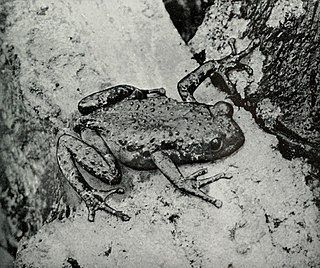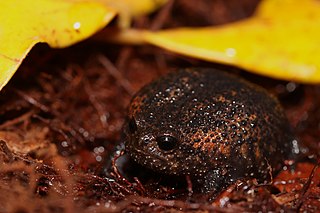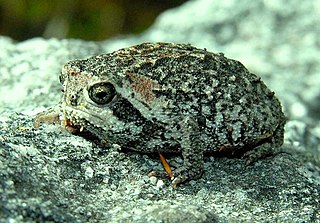
Phlyctimantis verrucosus is a species of frog in the family Hyperoliidae. It is found in central and eastern Democratic Republic of the Congo, northern Rwanda, and southern and western Uganda. It might be the same species as Phlyctimantis leonardi found further west, showing clinal variation; in any case, the border between these two species is not well known.

Alsodes verrucosus is a species of frog in the family Alsodidae. It is found in the Andes of Chile and Neuquén and Río Negro Provinces, Argentina. These frogs inhabit temperate Nothofagus forest where they occur under logs and near damp areas. Tadpoles develop in cold, deep streams. It is threatened by habitat loss caused by logging.
Telmatobius verrucosus is a species of frog in the family Telmatobiidae. It is endemic to Bolivia. Its natural habitats are subtropical or tropical moist montane forest and rivers. It is threatened by habitat loss.

Breviceps acutirostris, also known as common rain frog, strawberry rain frog, or Cape short-headed frog, is a species of frog in the family Brevicipitidae. It is endemic to the southwestern Cape region in South Africa. It is burrowing frog that lives in fynbos heatland and forests at elevations below 1,600 m (5,200 ft) above sea level. Development is direct . It is threatened by habitat loss, although much of its habitat is also protected.

Breviceps adspersus, also known as common rain frog, bushveld rain frog, and many other vernacular names, is a species of frog in the family Brevicipitidae. It is found in Southern Africa, in Angola, Democratic Republic of the Congo, Namibia, Botswana, Zambia, Zimbabwe, South Africa, Eswatini, and Mozambique.

Bilbo's rain frog is an amphibian species in the family Brevicipitidae, endemic to South Africa. The frog was named after Bilbo Baggins, the main character from The Hobbit by J.R.R Tolkien. The frog was named as such because the scientist who discovered it used to read the novel to his children. Its natural habitats are temperate grasslands and edges of wood plantations, wherein it spends most of its time in its burrow. The species is threatened by construction, maintenance of roads, silviculture, general habitat degradation/habitat loss, and by road traffic. As a result, it is listed as Near Threatened in the IUCN Red List of Threatened Species.

Breviceps fichus is a species of frog in the family Brevicipitidae. It is endemic to the central highlands of Tanzania. Common name highland rain frog has been proposed for it.

Breviceps fuscus, also known as black rain frog, plain rain frog, brown short-headed frog, and Tsitsikama rainfrog, is a species of frogs in the family Brevicipitidae. It is endemic to the southern coast of South Africa.

The cape rain frog or giant rain frog is a species of frog in the family Brevicipitidae. Adults grow up to 45 mm in length. It was the first African frog species to be scientifically described by Carl Linnaeus in 1758, under the name Rana gibbosa. It is the most common and largest of rain frogs. The name "rain frog" that is applied to the genus refers to a belief that these frogs bring rain.

The desert rain frog, web-footed rain frog, or Boulenger's short-headed frog is a species of frog in the family Brevicipitidae. It is found in Namibia and South Africa. Its natural habitat is the narrow strip of sandy shores between the sea and the sand dunes. It is threatened by habitat loss by such factors as mining and tourism.

The mountain rain frog is a species of frogs in the family Brevicipitidae.

The Mozambique rain frog, also known as the flat-faced frog, is a species of frog in the family Brevicipitidae. It is found in Botswana, Democratic Republic of the Congo, Eswatini, Malawi, Mozambique, South Africa, Tanzania, Zambia, Zimbabwe, and possibly Lesotho. Its natural habitats are dry savanna, moist savanna, temperate shrubland, subtropical or tropical dry shrubland, temperate grassland, subtropical or tropical dry lowland grassland, subtropical or tropical high-altitude grassland, arable land, pasture land and rural gardens.

The Namaqua rain frog or Namaqua short-headed frog is a species of frogs in the family Brevicipitidae. It is found in Namaqualand in western South Africa and extreme southern Namibia.

Breviceps poweri, the Power's rain frog or Power's short-headed frog, is a species of frog in the family Brevicipitidae. It is found in northeastern Angola east through Zambia, southern Democratic Republic of the Congo, and Malawi, to western Mozambique and northeastern Zimbabwe; possibly in Namibia. The specific name poweri honours John Hyacinth Power, Irish-born director of the McGregor Museum who collected amphibians as well as reptiles and plants.

Rose's rain frog or Rose's rainfrog is a species of frog in the family Brevicipitidae. It is endemic to the sandveld of south-western coastal South Africa. It is less-frequently known as Rose's short-headed frog, Rose's Blaasop, or the sand rain frog. Some treat Breviceps fasciatus as a synonym of this species, although other authorities have expressed doubt.
The whistling rain frog is a species of frogs in the family Brevicipitidae. It is found in South Africa, Eswatini, and possibly Mozambique. Its natural habitats are temperate forests, dry savanna, moist savanna, and sandy shores. It is threatened by habitat loss.

The forest rain frog is a species of frog in the family Brevicipitidae. It is endemic to Limpopo, South Africa. Two allopatric subspecies are recognized: the nominate one, Breviceps sylvestris sylvestris, and Breviceps sylvestris taeniatusPoynton, 1963 from near Soutpansberg. Its natural habitats are temperate forests, temperate grassland, and rural gardens. It is threatened by habitat loss.

Cophixalus verrucosus is a species of frog in the family Microhylidae. It is endemic to Papua New Guinea. Its natural habitats are tropical moist lowland forests, moist montane forests, and heavily degraded former forest.
Pseudorana weiningensis is a species of true frog endemic to China. It is the only species in the genus Pseudorana. It is also known as the Weining frog or Weining groove-toed frog. Its natural habitats are temperate shrubland, temperate grassland, and rivers. It is threatened by habitat loss.
Kurixalus verrucosus is a species of frog in the family Rhacophoridae found in Myanmar, Thailand, China, and Vietnam. In the past, it has been considered synonym of Rhacophorus appendiculatus, which, together with other confusion regarding the identity of this species, makes interpreting older literature difficult. Its natural habitats are subtropical or tropical moist lowland forests, subtropical or tropical moist montane forests, rivers, and intermittent rivers. It is threatened by habitat loss.



















